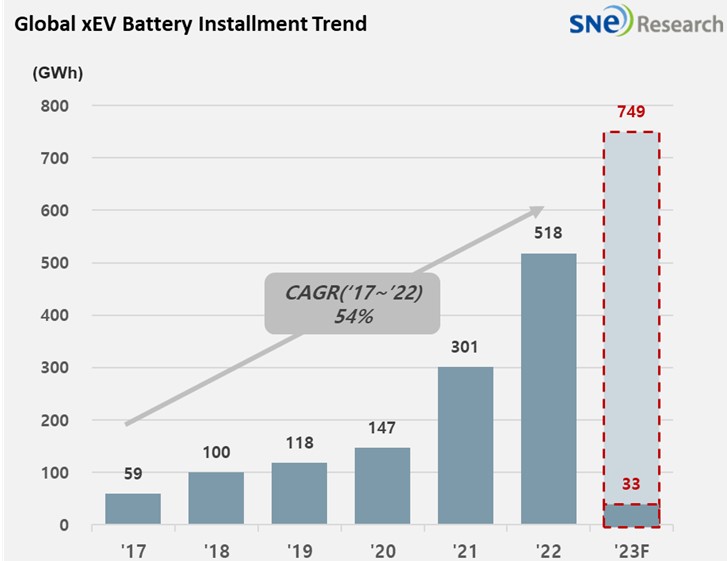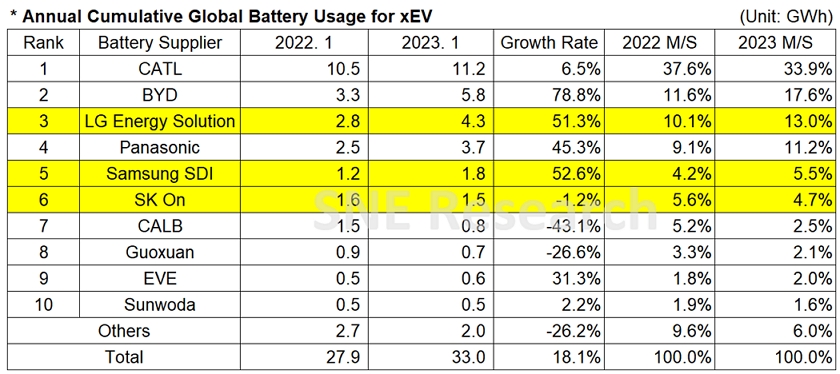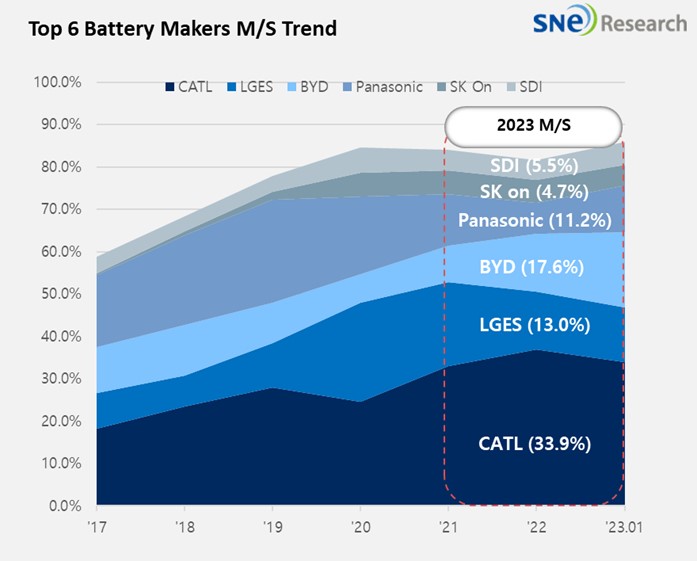In Jan 2023,
Global EV Battery Usage Posted 33.0 GWh, 18.1%
YoY Growth
- With K-trio M/S reaching 23.2%, BYD ranked 2nd and
LGES ranked 3rd
In January 2023, the amount of energy
held by batteries for electric vehicles (EV, PHEV, HEV) registered worldwide
was 33.0GWh, a 18.1% YoY increase. The upward trend in the market has continued
since the 3rd quarter of 2020. Based on the Global EV & Battery Monthly
Tracker provided by SNE, the global EV battery usage in 2023 is
expected to reach approximately 749GWh.

(Source: Global Monthly EV & Battery
Shipment Forecast – February 2023, SNE Research)
The market
shares of K-trio companies increased by 3.3%p from the same period of last year
to 23.2%. LG Energy Solution ranked 3rd with 4.3GWh, a 51.3% YoY
increase. SK-On recorded 1.5GWh, a 1.2% decline, and Samsung SDI posted 1.8
GWh, a 52.6% surge.
(Source: Global EV and Battery
Monthly Tracker – February 2023, SNE Research)
The upward
or downward trend in growth of battery cell makers was mainly affected by sales
of electric vehicle models equipped with batteries of each company. SK-On found
the sales of Hyundai Ionic 5, KIA EV6, and Ford F-150 noticeably helpful for
its battery sales but saw a decline in the sales of Kona BEV. Samsung SDI’s
growth was effectively led by steady sales of Audi E-Tron and BMW i4 and iX. A sudden
growth in sales of R1T, Rivian’s pick-up truck, also favorably affected Samsung
SDI. The growth of LG Energy Solution was based on solid sales of Tesla Model 3
and Y, Ford Mustang Mach-E, Chevrolet Bolt EUV, and Porsche Taycan EV.
Panasonic,
the only Japanese company in the top 10 on the list, posted 3.7GWh, a 45.3% YoY
growth, and witnessed its market share reviving by 2.1%p. As one of the major
battery suppliers to Tesla, Panasonic stayed on an upward track thanks to
increases in sales of Tesla models in the North American market and an increase
in sales of Toyota BZ4X.
Even
though CATL from China recorded a growth of 6.5%, below the market average, it
still occupied 33.9% of the entire market share, standing at the forefront of
the market as an unmatched leader. CATL’s continued growth was based on the
installation of CATL battery in Tesla Model 3 and Y, SAIC’s Mulan, Nio’s ET5,
and KIA’s Niro BEV. BYD, of which sales is mostly focused on the Chinese
domestic market, showed a high growth of 78.8% and took the 2nd
place on the list despite a decline in the EV sales in the Chinese market. Such
growth was achieved by selling a large number of BEV and PHEV from BYD who has
an advantage in cost competitiveness through in-house battery making and
vertical SCM integration.
(Source: Global EV and Battery Monthly Tracker – February 2023, SNE Research)
Although
the January EV (BEV+PHEV) sales in China has seen a 6.2% YoY decline due to the
termination of national subsidy policy in 2023, the market is still led by the
Chinese companies with CATL and BYD at the forefront. In February, the Ministry
of Industry and Information Technology of the People’s Republic of China announced
that it had a plan to accelerate the establishment of EV waste battery
recycling system. This announcement can be interpreted that China plans to
build a battery circulation system in the country as well as to prepare a solid
foundation for a stable take-off to the global stage. Amidst several
uncertainties in the market such as protectionist measures upheld by the US and
Europe and economic downturn, attentions should be drawn to counterstrategies
implemented by battery makers.
Forecast is updated every month in
accordance with the actual aggregated data of each month.




